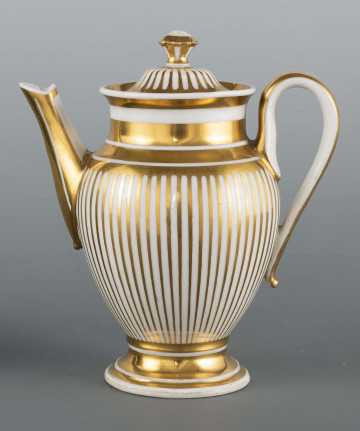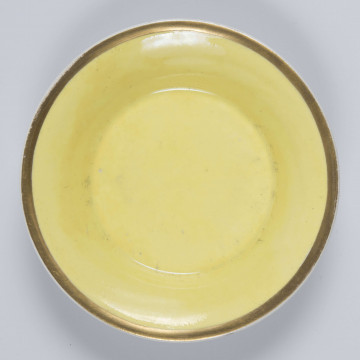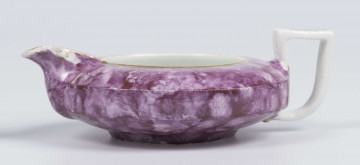
Coffee pot
1834
National Museum in Lublin
Part of the collection: European porcelain
The Royal Porcelain Manufactory in Berlin - Königliche Porzellanmanufaktur (KPM) - was founded by King Frederick II of Prussia. It was founded in 1763 based on private enterprises which, under the patronage of the Crown, began the production of "white gold" around the middle of the 18th century. The mark of KPM was the symbol of a sceptre. The company operated until the fall of the monarchy in 1918, when it was nationalised.
Under the royal administration the manufactory became one of the most important, operated as a profitable, efficient enterprise (no child labour, regular working hours, pensions, health care, assistance to widows and orphans). The factory carried out many orders, most of them from the sovereign himself. Frederick the Great ordered products for his palaces and for official gifts to the royal and aristocratic courts of Europe. Until his death in 1786, he commissioned twenty-one dinner services for himself, each consisting of thirty-six place settings and around five hundred separate pieces, complemented by elaborate table centrepieces. The shapes and colours of the wares were matched to the interior design of the target rooms. The Berlin dishes rank among the finest works of German Rococo. Some of the designs are still used today.
After the death of the King, the rococo forms gave way to clear lines of classicism. An outstanding example of the new style was the famous Kurland dinner service. It was named after its patron, Peter von Biron - the Duke of Courland, patron and collector of art. Many outstanding artists worked for the manufactory. Particularly noteworthy are the dishes and trinkets designed by J. G. Schadow, K. F. Schinkel in the Biedermeier period. In the first half of the 19th century the KPM also distinguished itself from other European manufactories in the production of porcelain paintings and vedutas.
A white cup with a floral motif in gilded interior dates from around 1820. Underneath the gold frieze on the spout with a floral thread pattern is a painted bouquet of forget-me-nots and the inscription: "Auch in der Ferne" [Even in the distance]. The words may have been taken from Goethe's poetry. It is how one of the lyrics of Księga Zulejki [The Book of Zulejka] from the collection Dywan Wschodu i Zachodu [The Carpet of East and West] from 1819 begins. The sentimental pictorial and textual message correspond to the purpose of the object, which was to be a tasteful and meaningful gift. Individual pieces of this group of wares differed in their decoration and the content of their sentences.
Author / creator
Dimensions
cały obiekt: height: 7,5 cm, width: 7 cm
Object type
dish
Technique
overglaze paints
Material
porcelain
Creation time / dating
Creation / finding place
Owner
The National Museum in Lublin
Identification number
Location / status

1834
National Museum in Lublin

1824 — 1828
National Museum in Lublin

1820 — 1830
National Museum in Lublin
DISCOVER this TOPIC
National Museum in Szczecin
DISCOVER this PATH
Educational path